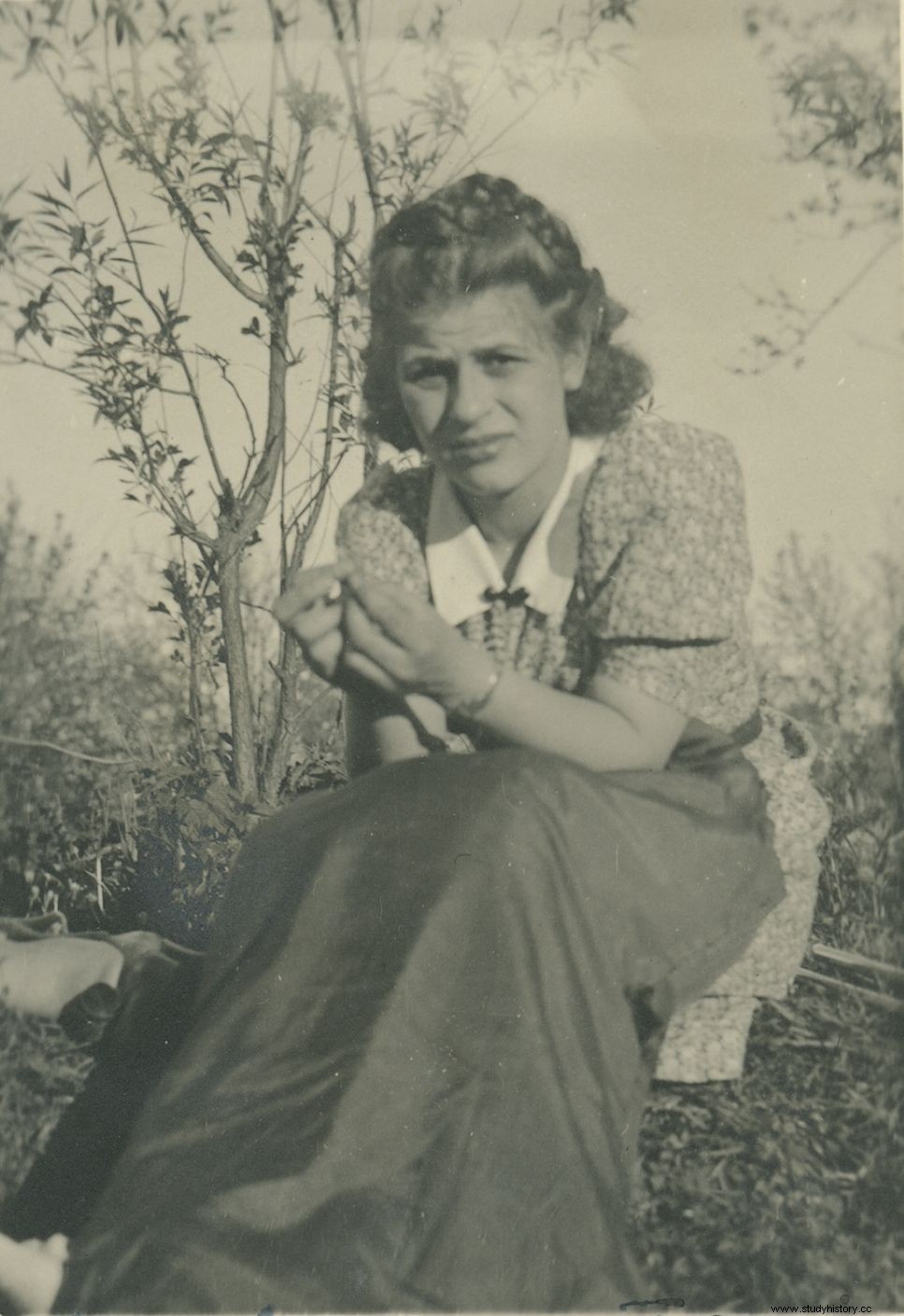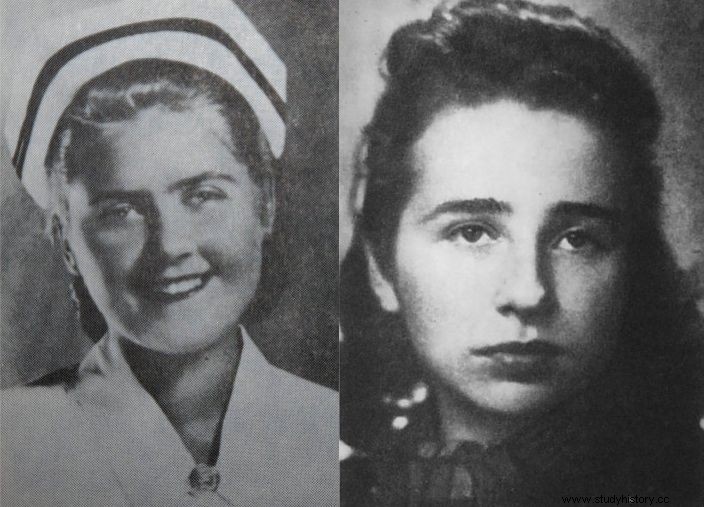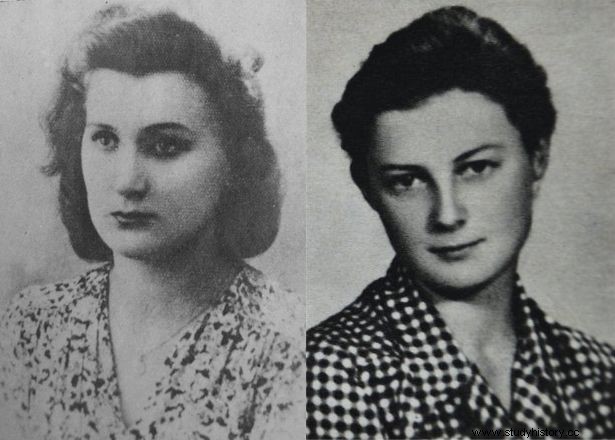They jumped with parachutes, carried explosives in bags, hid fugitives from ghettos, bandaged the wounded ... None of them could be denied heroism. And a lot:you can't deny a truly endearing beauty!

Alicja Wnorowska just before the war. A photo from the book "War Girls" (Znak Horyzont 2017).
Alicja Wnorowska as a skiing enthusiast, in winter she often organized downhill runs in the vicinity of her home town of Przemyśl. During one of such sports trips, she met Irka Szajowska, who works with the Intelligence Brigades. They became friends. It was at Irka's urging that Alicja decided to join the Home Army intelligence service. The girls were soon ordered to work in the military, militia or the Security Office. As a result of a fortunate coincidence, they were able to complete it quickly.
While dancing, Alicja caught the eye of the party's secretary, who offered her a job… in the Security Office. The girl agreed, and from then on, as an agent, she sent valuable information to the head of the intelligence service. It did not limit itself to transmitting names and data. Thanks to her letters and guarantees, many prisoners held at the office were released.

Halina Rajewska, photo from 1941. A photo from the book "Girls of War" (Znak Horyzont 2017).
Halina Rajewska since childhood, she dreamed of becoming a figure skater. At the age of 15, she took third place at the Polish championship. The war, however, thwarted her plans. The girl decided to use her energy in the actions of an unofficial conspiracy:thanks to contacts in the German police, she received information about planned arrests and resettlements. Halina, despite the enormous risk, sent warnings to those at risk. At the urging of her brother, she soon joined the Service for Poland's Victory.
Her innocent, girlish appearance contributed to the nickname "Dzidzia" and was a perfect cover for dangerous tasks. In 1941, she married Lech Wittig, also active in the underground (you can read the tragic story of their wedding in our other article).

Krystyna Wańkowicz (left) and Anna Wajcowicz (right).
Anna Wajcowicz As a liaison officer for the commander of the 2nd platoon "Alek", Lieutenant "Kołczana", she received the pseudonym "Hanka Kołczanka". A 20-year-old student of architecture at the secret Warsaw University of Technology during the occupation, she was also an intelligence officer of the Second Department of the Home Army Headquarters. In 1943 she was introduced to the "Zośka" battalion. Unfortunately, she also became the first girl from this unit to die in the Warsaw Uprising. She died while trying to pick up a gun from a car of the German police under fire by insurgents.
Krystyna Wańkowicz "Anna" in July 1944 she was inducted into the "Parasol" battalion by the commander of the 1st company, Stanisław Leopold "Rafał", and became his liaison officer. When people were searched for the retardation group, which was to cover the troops withdrawing from southern Wola, she volunteered. She died during an action near the Calvinist Cemetery. Her body could not be found.

Elzbieta Zawacka "Zo". The photo comes from the book "Wielka Księga Armii Krajowej" (Znak Horyzont 2015).
Elżbieta Zawacka she was the only woman among the Cichociemni and the second woman in Polish history (after Maria Wittek, head of the Women's Military Service) to be promoted to the rank of brigadier general. In 1939 she fought in Lviv, in 1944 - in the Warsaw Uprising. She quickly joined the underground and became a courier of the Home Army Headquarters.
As a liaison officer, she traveled around Europe, carrying reports and information. She crossed the border of the Reich many times, always happily returning to the country, sometimes in a daring manner (jumping with a parachute). After the war, repressed by the communists, she spent several years in prison. Even though she had a chance to die many times, she lived to be less than 100 years old.

Elżbieta Dziębowska (left) and Anna Zakrzewska (right).
Elżbieta Dziębowska "Dewajtis" she was a scout girl of the Gray Ranks. Together with other girls, she underwent military training in 1943 and was transferred to the special tasks unit "Agat" (later "Parasol"). In the same year, together with the soldiers from the detachment, she also began studying secret classes. Soon she was assigned to the intelligence cell of standard-bearer Aleksander Kunicki "Rayski". She participated in many combat operations, including the famous attack on Franz Kutschera. After the war, she began studying musicology - she became the head of the Department of History and Theory of Music at the Jagiellonian University, and also lectured at the Academy of Music in Krakow.
"Hanka Biała", as Anna Zakrzewska was called , belonged to the Gray Rank Assault Groups, then to the Kedyw of the Home Army Headquarters. She died at the age of 18 during the retreat of the "Radosław" group from Wola. Earlier, however, she managed to hand over the order to the platoon commander "Felek" to leave the position and retreat to St. Kinga.

Teresa Bogusławska (left) and Zuzanna Ginczanka (right). Photo of Ginczanka from around 1938.
Teresa Bogusławska is called the youngest poet of the Warsaw Uprising. The scout girl of the 6th Warsaw Women's Scout Team of the Gray Ranks, participated in the "Little Sabotage". During one of the actions in 1944, she was arrested by the Germans, imprisoned in Pawiak and tortured. Due to her health condition, she did not take part in line operations during the uprising, but helped fighters by sewing uniforms and completing first aid kits. Her poems are remarkably mature:“Goodbye forests and goodbye, fields, / Goodbye, golden fields in the sun of cereals. / I will never come back to you captivity, / I will not come back to you? - well… ”- she wrote in 1941, when she was 12.
Zuzanna Ginczanka Although not directly related to the Home Army, she was, like Teresa, a poet-victim of the war. Her works from the 1930s promised a great literary talent; she published, among others, in the famous "Skamander", she was friends with Julian Tuwim and Witold Gombrowicz. The war brutally interrupted her career. In 1944, she was arrested by the Gestapo and shot in the yard of the prison at Montelupich in Kraków.

Zofia Jarkowska-Krauze (left) and Janina Trojanowska-Zborowska (right).
Janina Trojanowska-Zborowska "Nina" She joined the Gray Ranks together with the Żoliborz group of the self-education organization "PET". In 1943, she was transferred to the special unit "Agat" of the Kedyw of the Home Army Headquarters, where she became a liaison for second lieutenant "Jeremi", the deputy commander. A year later, "Nina" and "Jeremi" got married - their wedding took place on August 17th. However, they were not given a long life together - on the night of September 22-23 they were captured by the Germans together with other wounded soldiers of the "Radosław" and "Kryska" groups. In the morning she was seen in a column of prisoners led towards Sipo's headquarters in al. Szucha. There her hearing was lost.
That same morning, another young wife, Zofia Jarkowska-Krauze , died . "Zosia", as a graduate of the Warsaw School of Nurses, was an ideal candidate for a nurse. At the beginning of the uprising, she worked in a sanitary facility in Śródmieście; during the bombing, she was on duty on the roofs of tenement houses. On September 5, she married Second Lieutenant Wiktor Krauze "Andrzej Pol" in a makeshift basement chapel. The unfortunate night of September 22-23, the husband of "Zosia" participated in the unsuccessful breakthrough to Śródmieście Południe. After the action, he hid with his wife and other nurses in the ruins of the basement at ul. Wilanowska. The group decided that in the morning they would try to break through towards the downtown escarpment. "Zosia" did not reach her destination - she was hit by fragments of a grenade launcher.

Zenobia Żurawska, graduation photography (1937). The photo comes from the book "War Girls" (Znak Horyzont 2017).
Zenobia Żurawska she loved math; she was the best in the subject in her final exams. This made her choice of studies:at the outbreak of the war, she would start the third year of mathematics at the University of Warsaw. In September 1939, in the case where the timetable was usually hung, an announcement about the enlistment of the "human torpedoes" unit appeared. About 150 women were among the volunteers ready to undertake suicide missions, including Zenia.
She was never called upon to undertake a suicide mission, but soon had the opportunity to prove her courage once again. From 1940, in parallel with the sanitary course, she started working in the underground - tracking informants. As a nurse, she also took part in many actions, including taking over weapons from transports on the Wołomin-Tłuszcz line.

Zofia Kasperska (left) and Teresa Wilska (right).
Teresa Wilska "Bożena Czarna" she was active in the underground since 1941 - she belonged to the 5th Warsaw Women's Scout Team. From September 1942, she was a liaison officer in the Communications Battalion of the Warsaw District of the Home Army - as a sewer guide on the Śródmieście-Old Town route, she repeatedly led soldiers under the streets of Warsaw. After the fall of the Old Town, she was dismissed from service and returned to her home in Czerniaków. However, the will to act prevailed - in early September she volunteered for the armored platoon "Wacek" of the "Zośka" battalion. After the fall of the uprising, she escaped from a transport to a transit camp in Pruszków. After the war, she worked as a biology teacher in a high school, she also ran a scout team. He currently lives in Warsaw.
"Zosia Żelazna" - Zofia Kasperska - during the occupation, she was involved in the education of girls from primary schools. While studying at the State Gymnasium and Secondary School for Girls Narcyza Żmichowska was also tutoring geography and history in secret classes. She passed her high school diploma in the same year that the uprising broke out. In 1940, she began her underground activity in Szary Szeregi, then in Kedywo. She took part in numerous actions:transferring weapons from hiding places and secret warehouses to contact points, and delivering conspiratorial materials.

Jadwiga Wolska, photo from 1943. The photo comes from the book "Wielka Księga Armii Krajowej" (Znak Horyzont 2015).
Jadwiga Wolska she liked to brush her hair like Greta Garbo and according to her friends she was similar to the famous actress, which gave her the nickname "Greta". Before the war, she studied at the Jagiellonian University. In 1941, she left for Warsaw, where she became involved in the conspiracy and was assigned to the "enki" (Sub-Department of Diversion Propaganda "N" at the Propaganda Department of BIP).
Her insurgent wedding with Jan Nowak-Jeziorański on September 7, 1944 became a famous event, although "the priest was in a hurry to the funeral and the ceremony lasted no more than seven minutes", as the then groom wrote in his memoirs "Kurier z Warszawy". It was thanks to her and her husband that the West saw the photos and videos taken during the uprising. For these merits she was promoted to the rank of lieutenant and awarded with the Cross of Valor.

Halina Chlistunow (left) and Jadwiga Piłsudska (right). The photos come from the book "Girls of war" (Znak Horyzont 2017).
In the fall of 1940, Halina Chlistunow she received an offer from her friend to join the AGM. She agreed - she became a liaison officer at BIP. Initially, her tasks were to distribute huge packages of leaflets around the city, hidden in baskets and covered with vegetables or flowers. Soon she started working as a kindergarten teacher - she looked after the children for five hours a day, and spent the rest of the day working in the underground. She took part in the executive actions twice, investigating informers. In the second case, a disguise helped her - in a handkerchief tied under her chin and with a bubble in her hand, she pretended to be a girl carrying milk.
When the news of mobilization for the uprising reached her in 1944, apart from bandages and matches, she also packed her favorite dress - so that there was something to celebrate the victory. It turned out that everyday life in fighting Warsaw has nothing to do with pathos, but Halina did not give up - she took care of transferring reports. She liked to move around the city at night, thanks to which she gained the nickname "Alika lunatyczka".
Jadwiga Piłsudska as the Marshal's daughter, she had contact with the elites of the Second Polish Republic since she was a child. Her interests were not typical of a pre-war lady - she was interested in airplanes. It turned into a passion for life. As a seventeen-year-old she took her first gliding course and in two years she obtained a D category (highest) glider badge, becoming the youngest holder of a gliding license in this category in Poland.
When the war broke out, Jadwiga really wanted to get involved in the service. Contrary to these intentions, she was sent to Great Britain with her mother and sister. There she began her studies at Cambridge; after their completion, she was admitted to the ATA (Air Transport Auxiliary), a service cooperating with the RAF and dealing with military air transport. As a pilot, ATA ran many types of machines - from school biplanes to Hurricanes and Spitfires (read more about Jadwiga and other Polish women piloting fighter jets).
